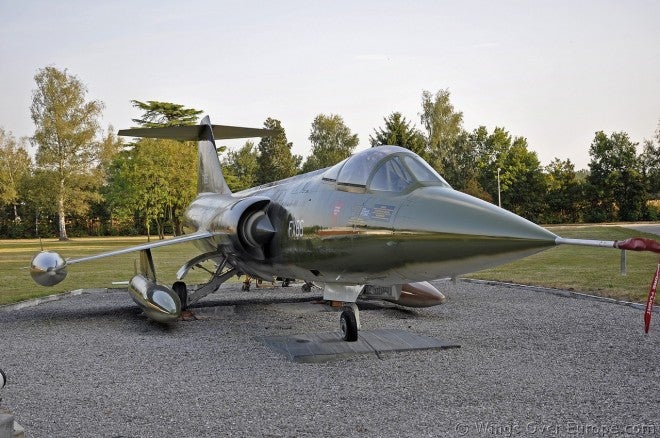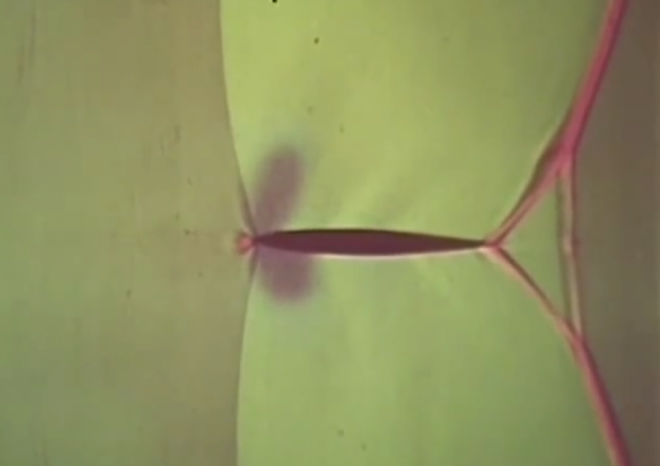The flight of a rifle bullet may seem to be a simple thing – it flies through the air at high speeds, steadily losing velocity and energy until it either impacts the dirt or simply falls out of the sky. In fact, though, there is a lot of complex fluid dynamics to absorb to fully understand the flight of a bullet through the air, especially as that bullet drops below Mach 1.3 (about 1,450 ft/s) and encounters the transonic flight regime. To help us understand what happens better, we’ll turn to an instructional video from the 1950s from Shell Oil; while it covers the flight of then-high-performance aircraft, not bullets, the basic principles still remain the same. I highly recommend my readers watch the video first, before reading my discussion of it:
The flow animations shown in the video illustrate perfectly the fluid dynamics of transonic airflow over wings. These animations apply to bullets, as well, however the flow is radial, around the bullet, instead of linear as along a wing. One of the effects noted in the video – flow separation – will affect bullets in a similar way as wings; bullets as they travel beyond the high point in their trajectory fly through the air with a positive angle of attack – they are canted upwards – as they are stabilized by the rifling. Therefore, they are generating some lift, just like a wing (though much, much less). When they enter the transonic flight regime, they will experience flow separation, which can seriously affect their accuracy during that part of flight.
A bullet’s shape can be improved for supersonic flight, just like an airplane’s can. Unlike an airplane, a bullet does not have wings or other significant protrusions, and therefore area ruling is expressed more subtly. We can see how area ruling might work on a bullet, shown below:
![2015-03-08 00_41_32-SolidWorks Premium 2013 x64 Edition - [Sketch1 of 5.56M855bullet.SLDPRT _]](https://www.thefirearmblog.com/blog/wp-content/uploads/2015/03/2015-03-08-00_41_32-SolidWorks-Premium-2013-x64-Edition-Sketch1-of-5.56M855bullet.SLDPRT-_-660x585.png)
This is a radial section of a flat-based, tangent ogive conventional bullet. We can see that the bullet’s shape does not conform well to the curve inscribed on it on the right. Area ruling is needed to bring the bullet’s shape closer to that of the curve, reducing drag and improving the bullet’s transonic characteristics.
![2015-03-08 00_35_57-SolidWorks Premium 2013 x64 Edition - [Sketch1 of 5.56M855bullet.SLDPRT _]](https://www.thefirearmblog.com/blog/wp-content/uploads/2015/03/2015-03-08-00_35_57-SolidWorks-Premium-2013-x64-Edition-Sketch1-of-5.56M855bullet.SLDPRT-_-660x516.png)
The same bullet, area-ruled to the curve. A boattail has been added in the correct location to conform closely to the shape of the curve, and the ogive has been changed to a secant-type matching a section of the curve. This bullet will have a much higher ballistic coefficient, and be more resistant to transonic buffeting – thanks to it having a higher critical Mach number, improving its long-range accuracy and hitting power.

We can see a similar shape expressed in this Luftwaffe F-104G Starfighter. The F-104 was one of the earliest fighters designed through a good understanding of supersonic airflow; in dramatic contrast to earlier high-speed aircraft, it possesses an area-ruled fuselage, sharp angles, thin wings, and an all-moving tailplane set high on the vertical stabilizer. Image source: wingsovereurope.com.
With careful bullet design, transonic buffeting can be reduced or nearly eliminated, dramatically improving long-range accuracy. Further, in doing so drag can be dramatically reduced, leading to greatly improved long-range velocity and striking power.
Unlike a plane, a bullet does not fly at low speeds, then accelerate to high speeds, then decelerate to low speeds again; throughout its flight, the projectile of a rifle decelerates. What this means is that the description of a rifle crack as “the noise a bullet makes when it breaks the sound barrier” is not quite correct; a bullet actually crosses the sound barrier from supersonic flight to transonic flight. In fact, the crack of a rifle is a sonic boom, just like that produced by an airplane, and is generated throughout the bullet’s supersonic flight path.
Certainly, a someone trying to create refined understanding of small arms should not restrict themselves only to material pertaining directly to it; physics applies everywhere, and older learning aids like this one can be a big help improving your understanding of a topic.
 Your Privacy Choices
Your Privacy Choices
